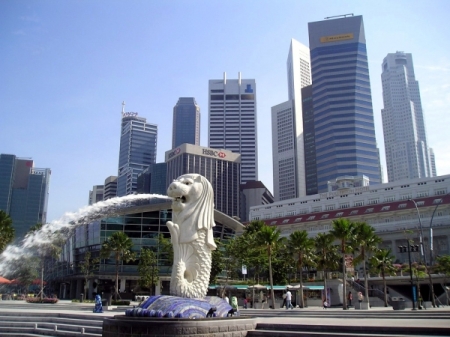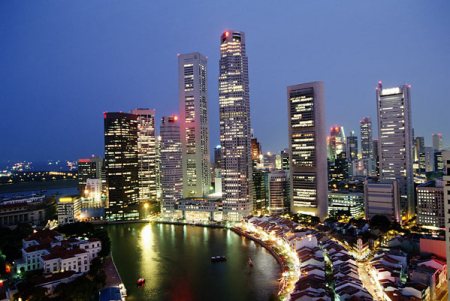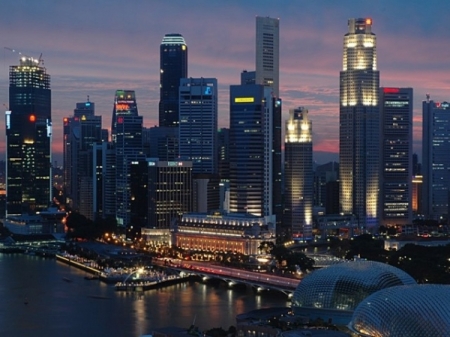Beguiling Singapore is a modern city-state embracing economic progress against the backdrop of age-old tradition. The customs that underpin community life are created out of a cultural mix that includes predominantly Chinese, Indian and Malay ethnic groups.
Singapore is a land of stark contrast, from one of the sleekest cleanest cities in the world you can also find authentic asian foods and goods for a very reasonable price. Singapore is quite possibly the only city in the world famous for making the sale and chewing of gum illegal, and regulating the length of male haricuts in some places. Shopping is very cheap in Singapore and many of the more expensive holiday activities such as Scuba Diving and yachting can be found for a very affordable price from reputable professionals in the field.
It is also called a “fine” city, as fines are levied for spitting, jaywalking, littering and smoking in air-conditioned public places including restaurants. The sale and importation of chewing gum is also banned. Most Singaporeans do not live in the city centre, but in vast high-rise government housing estates spread around the island and rarely visited by tourists. The water is safe to drink. Drugs are illegal and there is an automatic death penalty for drug traffickers.
There is something for everyone, local traditions, history, cultural mix; a restful holiday or just shop-till-you-drop. The country is well-suited to those looking for a gentle introduction to Asia, it is completely Westernised.
Hotels are mainly located in the area from Orchard Road through to Marina Square. Most are high-rise (at least one has over 70 floors) and the broad choice ranges from the famous Raffles hotel to cheaper options in Chinatown and Little India.
During the daytime attractions include golf , public tennis and squash courts, privately run gyms. Spectator sports including football, cricket, rugby and horse racing. Water sports – wind surfing, canoeing, sailing and water-skiing along the SE coast, Changi and Punggol.
Orchard Road is a shopper’s heaven. Around a mile of glossy shopping centres sell all big designer names (but often for similar prices as UK) as well as cheaper imitations. Shops selling cameras, watches and stereo systems abound. To see the real Singapore, visit People’s Park in Chinatown (Chinese department stores and cheaper shops), Little India and Arab Street. Most shops open mid-morning and close around 9pm, 365 days of the year.
Evening brings an array of activity especially in larger hotels, many bars and coffee shops. UK style nightclubs attracting big-name DJs from London and New York, theme bars.
Singapore City
The Downtown Core is a 266-hectare urban planning area in the south of the city-state of Singapore. The Downtown Core surrounds the mouth of the Singapore River and southeastern portion of its watershed, and is part of the Central Area, Singapore’s central business district. It is one of the most dense areas in Singapore, even more than other divisions in the Central Area, to the extent that much of it is filled with skyscrapers. As its name implies, it forms the economic core of Singapore, including key districts such as Raffles Place and key administrative buildings such as the Parliament House, the Supreme Court and City Hall as well as numerous commercial buildings and cultural landmarks.
Sights in Singapore are covered in more detail under the various districts. Broadly speaking:
- Beaches and tourist resorts: Head to one of the three beaches on Sentosa or its southern islands. Other beaches can be found on the East Coast.
- Culture and cuisine: See Chinatown for Chinese treats, Little India for Indian flavors, Kampong Glam (Arab St) for a Malay/Arab experience or the East Coast for delicious seafood, including the famous chilli and black pepper crab.
- History and museums: The Bras Basah area east of Orchard and north of the Singapore River is Singapore’s colonial core, with historical buildings and museums.
- Nature and wildlife: Popular tourist attractions Singapore Zoo, Night Safari, Jurong Bird Park and the Botanical Gardens are all in the North and West. Finding “real” nature is a little harder, but the Bukit Timah Nature Reserve (located in the same district as the zoo) has more plant species than that in the whole of North America. Pulau Ubin, an island off the Changi Village in the east, is a flashback to the rural Singapore of yesteryear. City parks full of locals jogging or doing tai chi can be found everywhere.
- Skyscrapers and shopping: The heaviest shopping mall concentration is in Orchard Road, while skyscrapers are clustered around the Singapore River, but also check out Bugis and Marina Bay to see where Singaporeans shop.
- Places of worship: Don’t miss this aspect of Singapore, where Buddhism, Taoism, Hinduism, Sikhism, Baha’i faith, Christianity, Islam and even Judaism all exist in sizeable numbers. Religious sites can be easily visited and welcome non-followers outside of service times. Particularly worth visiting include: the vast Kong Meng San Phor Kark See Monastery near Ang Mo Kio, the colorful Sri Mariamman Hindu temple in Chinatown, the psychedelic Burmese Buddhist Temple in Balestier and the stately Masjid Sultan in Arab Street.







0 comments:
Đăng nhận xét